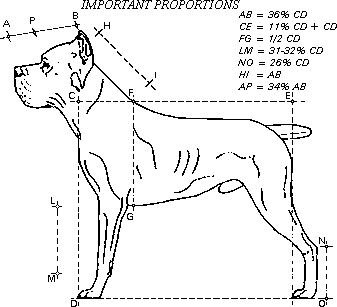Breed Standard



Note: I see people comment all the the time that they don’t want “boxer” lines. From a genetic study we know the Cane Corso in the US shares haplotypes with the Neapolitan Mastiff (US+Italy), Cane Corso (Italy), Boxer, Bullmastiff, Mastiff, Boerboel, Rottweiler, Dogue de Bordeaux, Bulldog, and St Bernard. We know that the Cane Corso in Italy shares haplotypes with the Neapolitan Mastiff (US+Italy), Cane Corso (US), Boxer, Bullmastiff, Mastiff, Boerboel, Dogue de Bordeaux, Bulldog, and St Bernard. The reason we see so many different types is because of this. Typically, the older American lines will have heavy influence from the Rottweiler and Neapolitan. It is not any more pure than the older Italian lines. Ultimately, breeders should be focusing on the standard and breeding towards that. A breeder should be able to understand the pros and cons of their dogs so they can pair that dog with another dog that complements them.
Official Standard of the Cane Corso (Pronounced KAH-NAY KORSO)
General Appearance: Ancient Italian breed medium-large size Molossus Dog. Sturdy, with a strong skeleton. Muscular and athletic, it moves with considerable ease and elegance. It has always been a property watchdog and hunter of difficult game such as the wild boar.
Size, Proportion, Substance: A muscular, balanced, large-boned dog, RECTANGULAR in proportion. The length of the dog, measured from the point of the shoulder to the point of buttock is approximately 10 percent greater than the height of the dog measured from the highest point of the shoulder to the ground.
Height - Dogs 25 to 27½ inches; bitches 23½ to 26 inches. Weight - Proportionate to height.
Head: Molossus, large, its total length reaches approximately one third of the height at the withers. Planes of the skull and muzzle are slightly convergent; they are not parallel. The circumference of the head measured at the cheekbones is more than twice the total length of the head; skin is firm and smooth.
Skull - Viewed from the front, skull is wide and slightly curved; width is equal to the length. From the side, a prominent arch begins above the eyes and then flattens backward toward the occiput. Viewed from the top, it has a square appearance due to the zygomatic arches and powerful muscles swathing it.
Stop - Well-defined due to developed and bulging frontal sinuses and prominent arch above the eyes.
Expression - Very alert and attentive. Some wrinkling on forehead occurs when alert.
Eyes - Medium-size, almond-shaped, not round or bulging, tight fitting rims preferred with only a minimal amount of haw being visible.
Eye color - Dogs with black muzzles (coat colors of black, fawn or red, and these colors brindled) dark brown eyes are preferred. Gray muzzles (coat colors of gray, fawn or red and these colors brindled), lighter shades are approved. Pigmentation of the eye rims is complete, pigmentation of eye rim matches pigment color of dog. Disqualification - Yellow bird of prey; blue eyes.
Ears - Set well above the cheekbones. May be cropped or uncropped. If cropped, it is in an equilateral triangle. If uncropped, they are medium size, triangular in shape, held tight to the cheeks, and not extending beyond the jaw bone.
Nose - Large with well-opened nostrils, pigment color to match pigment color of the dog. Dogs with black pigment have black noses; gray pigmented dogs have gray noses; pigmentation is complete. The nose is an extension of the topline of the muzzle and does not protrude beyond nor recede behind the front plane of the muzzle.
Muzzle - Very broad and deep, width is almost equal to its length, which reaches approximately one third of the total length of the head; the depth of muzzle is more than 50 percent of the length of the muzzle. The top and bottom muzzle planes are parallel, and the nose and chin form a perpendicular line. Viewed from the front, the anterior face should look flat and form a trapezoid, wider at the bottom. Muzzle is not overly narrow or snipey.
Lips - Rather firm. Upper lips moderately hanging, they join under the nostrils to form an inverted "U." Pigmentation matches color pigment of dog. Dogs with black pigment have black lips; gray pigmented dogs have gray lips.
Bite - Slightly undershot (no more than ¼ inch) and level preferred. Scissor bite is acceptable, if parameters of the head and muzzle are correct. Dentition is complete. Incisors are in a straight line. No more than two missing teeth. Disqualification - More than two missing teeth; wry mouth. Undershot more than ¼ inch.
Neck, Topline, Body: Neck-Slightly arched, flowing smoothly into the shoulders with a small amount of dewlap. The length of the neck is approximately one third the height at the withers. Body - Depth of the ribcage is equal to half the total height of the dog, descending slightly below the elbow. Ribs are long and well sprung. Moderate tuck up. Chest - Broad, well-muscled, strong